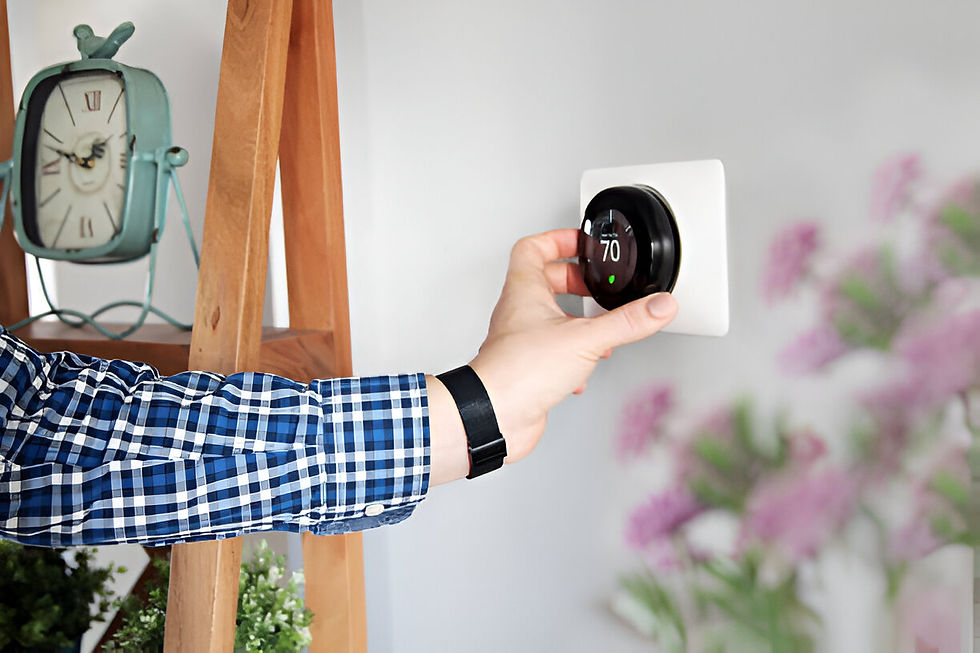When to Replace an Old Thermostat Before It Fails
- housespecialist
- Mar 25
- 4 min read
A thermostat might seem like a small part of your HVAC system, but it plays a crucial role in keeping your home comfortable. Over time, even the best thermostats start to wear out, leading to inconsistent temperatures, higher energy bills, and potential HVAC problems. Many homeowners don’t think about replacing their thermostat until it completely stops working, but waiting too long can cause unnecessary discomfort and inefficiency. Knowing when to upgrade your thermostat can save you money and ensure your home stays comfortable year-round.

Signs Your Thermostat Needs Replacement
Your thermostat is responsible for communicating with your heating and cooling system, ensuring that it turns on and off at the right times. When it starts to fail, you may notice small but frustrating issues that affect your home’s comfort. If your thermostat is more than ten years old, it may not be working as efficiently as it should. Older models can struggle with accuracy, causing your HVAC system to run longer than necessary or not run enough. Another warning sign is inconsistent temperatures throughout your home. If some rooms are too warm while others are too cold, your thermostat could be struggling to regulate the system properly. Frequent short cycling—when your HVAC system turns on and off too quickly—can also indicate a failing thermostat. Short cycling puts extra stress on your system and increases energy costs.
Professional Thermostat Replacement by Professionals
When your thermostat starts showing signs of wear, the best solution is to upgrade before it completely fails. Professional thermostat replacement by Gulf Shore Cooling ensures that you get a modern, high-quality thermostat installed correctly and calibrated for optimal performance. Upgrading your thermostat not only improves temperature accuracy but also enhances energy efficiency and overall HVAC system performance. Newer thermostats offer advanced features, such as programmable settings and smart technology, allowing you to control your home’s temperature remotely and optimize energy usage. If your thermostat is outdated or causing problems, replacing it with a professionally installed model will make a significant difference in your comfort and utility bills.
The Impact of an Aging Thermostat on Your HVAC System
A failing thermostat doesn’t just make your home uncomfortable—it also puts unnecessary strain on your heating and cooling system. When a thermostat sends incorrect temperature readings, your HVAC system may run longer than needed, causing unnecessary wear and tear on components. Over time, this can lead to more frequent breakdowns and expensive repairs. Additionally, an inefficient thermostat can cause your energy bills to rise as your system works harder to maintain the desired temperature. By replacing an old thermostat before it fails, you can prevent unnecessary damage to your HVAC system and extend its lifespan.

Benefits of Upgrading to a Smart Thermostat
If you’re replacing an old thermostat, consider upgrading to a smart thermostat for even better efficiency and control. Technology's place in contemporary HVAC solutions is evident in these advanced devices, which learn your heating and cooling preferences, automatically adjusting the temperature to maximize comfort while reducing energy waste. Many models can be controlled remotely through a smartphone app, allowing you to adjust the temperature when you’re away from home. This feature is especially useful for homeowners who travel frequently or have unpredictable schedules. Smart thermostats also provide energy usage reports, helping you understand your consumption patterns and find ways to save on your energy bills. With a professional installation, you can ensure that your smart thermostat is set up correctly for optimal performance.
Avoid Emergency Repairs with a Timely Thermostat Replacement
Many homeowners don’t think about their thermostat until it stops working completely. Unfortunately, a sudden thermostat failure can leave you without heating or cooling at the worst possible time. Replacing an old thermostat before it fails allows you to avoid emergency repairs and unexpected discomfort. If your thermostat is already showing signs of malfunction, upgrading now will save you the hassle of dealing with a broken system when you need it most. Scheduling a professional replacement ensures that your new thermostat is installed and calibrated properly, so you won’t have to worry about unexpected breakdowns.
How to Choose the Right Thermostat for Your Home
When replacing your thermostat, it’s essential to choose one that fits your HVAC system and lifestyle needs. Basic programmable thermostats allow you to set heating and cooling schedules, helping to reduce energy consumption when you’re not at home. If you want even more control, a smart thermostat offers remote access, learning capabilities, and detailed energy reports. Before upgrading, check if your HVAC system is compatible with your chosen thermostat model. Some older systems may require additional wiring or a professional assessment to ensure compatibility. Consulting with HVAC experts, like those at Gulf Shore Cooling, can help you find the best thermostat for your home and ensure a seamless installation.
Conclusion
A failing thermostat can cause discomfort, higher energy bills, and unnecessary wear on your HVAC system. Instead of waiting for it to stop working, be proactive and upgrade to a modern, efficient model. Professional thermostat replacement by Gulf Shore Cooling ensures that your new thermostat is installed correctly, improving temperature control and energy efficiency. Whether you choose a basic programmable model or a high-tech smart thermostat, making the switch before your current thermostat fails will help keep your home comfortable and your HVAC system running smoothly. Don’t wait for a complete breakdown—upgrade your thermostat today and enjoy the benefits of better climate control and energy savings.



Comments